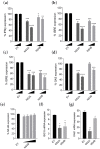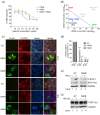INMI1 Zika Virus NS4B Antagonizes the Interferon Signaling by Suppressing STAT1 Phosphorylation
- PMID: 34960717
- PMCID: PMC8705506
- DOI: 10.3390/v13122448
INMI1 Zika Virus NS4B Antagonizes the Interferon Signaling by Suppressing STAT1 Phosphorylation
Abstract
The evasion of the Interferon response has important implications in Zika virus (ZIKV) disease. Mutations in ZIKV viral protein NS4B, associated with modulation of the interferon (IFN) system, have been linked to increased pathogenicity in animal models. In this study, we unravel ZIKV NS4B as antagonist of the IFN signaling cascade. Firstly, we reported the genomic characterization of NS4B isolated from a strain of the 2016 outbreak, ZIKV Brazil/2016/INMI1, and we predicted its membrane topology. Secondly, we analyzed its phylogenetic correlation with other flaviviruses, finding a high similarity with dengue virus 2 (DEN2) strains; in particular, the highest conservation was found when NS4B was aligned with the IFN inhibitory domain of DEN2 NS4B. Hence, we asked whether ZIKV NS4B was also able to inhibit the IFN signaling cascade, as reported for DEN2 NS4B. Our results showed that ZIKV NS4B was able to strongly inhibit the IFN stimulated response element and the IFN-γ-activated site transcription, blocking IFN-I/-II responses. mRNA expression levels of the IFN stimulated genes ISG15 and OAS1 were also strongly reduced in presence of NS4B. We found that the viral protein was acting by suppressing the STAT1 phosphorylation and consequently blocking the nuclear transport of both STAT1 and STAT2.
Keywords: NS4B; STAT1; STAT2; Zika virus; innate immunity; interferon; interferon evasion; phosphorylation.
Conflict of interest statement
The authors declare no conflict of interest.
Figures





Similar articles
-
Zika Virus Targets Human STAT2 to Inhibit Type I Interferon Signaling.Cell Host Microbe. 2016 Jun 8;19(6):882-90. doi: 10.1016/j.chom.2016.05.009. Epub 2016 May 19. Cell Host Microbe. 2016. PMID: 27212660 Free PMC article.
-
Infection with a Brazilian isolate of Zika virus generates RIG-I stimulatory RNA and the viral NS5 protein blocks type I IFN induction and signaling.Eur J Immunol. 2018 Jul;48(7):1120-1136. doi: 10.1002/eji.201847483. Epub 2018 Apr 6. Eur J Immunol. 2018. PMID: 29572905 Free PMC article.
-
Selective Activation of Type II Interferon Signaling by Zika Virus NS5 Protein.J Virol. 2017 Jun 26;91(14):e00163-17. doi: 10.1128/JVI.00163-17. Print 2017 Jul 15. J Virol. 2017. PMID: 28468880 Free PMC article.
-
The Potential Role of the ZIKV NS5 Nuclear Spherical-Shell Structures in Cell Type-Specific Host Immune Modulation during ZIKV Infection.Cells. 2019 Nov 26;8(12):1519. doi: 10.3390/cells8121519. Cells. 2019. PMID: 31779251 Free PMC article. Review.
-
Targeting Type I Interferon Induction and Signaling: How Zika Virus Escapes from Host Innate Immunity.Int J Biol Sci. 2023 Jun 4;19(10):3015-3028. doi: 10.7150/ijbs.83056. eCollection 2023. Int J Biol Sci. 2023. PMID: 37416780 Free PMC article. Review.
Cited by
-
Flavivirus NS4B protein: Structure, function, and antiviral discovery.Antiviral Res. 2022 Nov;207:105423. doi: 10.1016/j.antiviral.2022.105423. Epub 2022 Sep 27. Antiviral Res. 2022. PMID: 36179934 Free PMC article. Review.
-
Single-cell analysis reveals an antiviral network that controls Zika virus infection in human dendritic cells.J Virol. 2024 May 14;98(5):e0019424. doi: 10.1128/jvi.00194-24. Epub 2024 Apr 3. J Virol. 2024. PMID: 38567950 Free PMC article.
-
Zika Virus Neuropathogenesis-Research and Understanding.Pathogens. 2024 Jul 2;13(7):555. doi: 10.3390/pathogens13070555. Pathogens. 2024. PMID: 39057782 Free PMC article. Review.
-
Single-cell transcriptomics and network pharmacology reveal therapeutic targets of Jianpi Yiqi Bugan Yishen decoction in immune cell subsets of children with myasthenia gravis.Transl Pediatr. 2022 Dec;11(12):1985-2003. doi: 10.21037/tp-22-593. Transl Pediatr. 2022. PMID: 36643680 Free PMC article.
-
Structures and Dynamics of Dengue Virus Nonstructural Membrane Proteins.Membranes (Basel). 2022 Feb 17;12(2):231. doi: 10.3390/membranes12020231. Membranes (Basel). 2022. PMID: 35207152 Free PMC article. Review.
References
Publication types
MeSH terms
Substances
LinkOut - more resources
Full Text Sources
Medical
Research Materials
Miscellaneous

